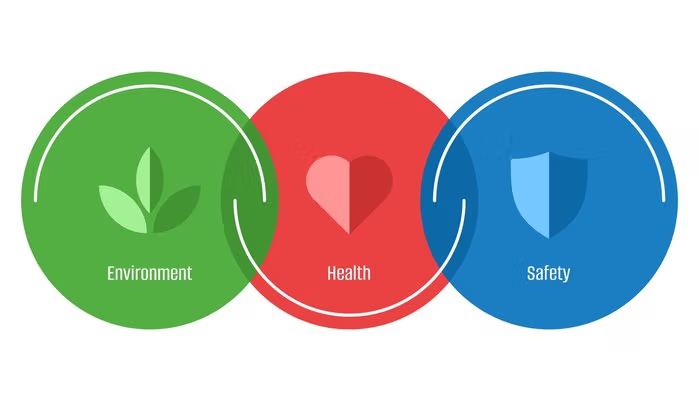Summary: The significance of EHS, in safety and health management should not be underestimated. The implementation of an efficient EHS management framework empowers organizations to safeguard the environment establish a work atmosphere adhere to regulations and enhance effectiveness. By giving priority to EHS companies showcase their dedication to employee well-being and operational sustainability. Embracing EHS principles helps mitigate risks while fostering a culture of safety and accountability. Let’s strive to integrate EHS into our core for a healthier and more sustainable future.
What is EHS?
EHS, short, for Environmental Health and Safety involves an approach to safeguarding the environment preventing workplace risks, and enhancing the well-being of individuals. It encompasses a variety of tasks such as identifying hazards assessing risks complying with regulations providing training and managing incidents.
Why does EHS matter?
EHS holds importance in preserving both the environment and the welfare of employees. By addressing dangers implementing safety measures and following environmental guidelines organizations can establish a healthy work environment. Additionally, EHS contributes to the long-term sustainability and reputation of a company.
The Role of an EHS Management System
What exactly is an EHS Management System?
An EHS management system serves as a framework that assists organizations in managing and integrating various components related to environmental health and safety. It offers an approach to identify risks assess them accurately and ensure compliance with regulations.
The Significance of an EHS Management System
An effective EHS management system is essential for upholding standards in safety and health management. By establishing policies, procedures, and guidelines organizations can mitigate risks efficiently prevent incidents, from occurring, and respond promptly to accidents when they do happen. Moreover, it fosters a culture of safety within the organization while supporting improvement efforts.
Creating a Safe Workplace
Environmental Health and Safety (EHS) covers a range of measures to ensure a work environment, for staff. This involves putting in place safety programs providing training and following safety protocols within company EHS departments. The guidelines set by the Occupational Safety and Health Administration (OSHA) are vital in this regard.
Maintaining a safe work environment not only protects employees but also boosts productivity and morale. By identifying and addressing EHS hazards organizations can protect their workforce and the surroundings from health and safety risks. EHS plays a role in helping companies enhance their impact and reduce risks to the environment.
Employees must receive EHS training so they understand how their environment impacts their well-being. This knowledge empowers them to identify hazards and contribute to workplace health and safety efforts. Investing in EHS initiatives showcases a company’s dedication to safeguarding its employees while minimizing its impact.
Ensuring Employee Safety and Health
EHS initiatives focus on ensuring employee safety and well-being by providing equipment (PPE) offering regular safety training and fostering a culture of safety. Companies that prioritize employee welfare demonstrate their commitment, to their staff reduce absenteeism rates, and enhance employee satisfaction.
Ensuring Adherence, to Safety and Health Guidelines
Companies must adhere to a range of safety and health guidelines to maintain a healthy work environment. Failure to comply with these guidelines can lead to fines, consequences, harm to reputation, and most importantly jeopardize the well-being of employees. By establishing an Environmental Health and Safety (EHS) program organizations can keep abreast of regulations. Uphold compliance.
Addressing Dangers and Vulnerabilities
EHS programs assist organizations in recognizing and addressing dangers and vulnerabilities linked to their operations. This includes evaluating the risks posed by materials, machinery, and procedures. Through the implementation of controls and preventive measures companies can decrease the occurrence of accidents reduce health hazards well and safeguard employees and the surroundings.
Is your organization effectively managing environmental, health, and safety risks?
EHS Software streamlines compliance, reporting, and risk mitigation.
Crucial Components of an EHS Management Framework
An EHS management framework consists of crucial components such as; Identification of Hazards and Risk Assessment; This entails pinpointing hazards in the workplace while evaluating their associated risks. Adherence to Regulations; Companies must keep up to date with EHS regulations while ensuring compliance to avoid penalties and legal complications.
Development; Offering employees training programs helps enhance awareness levels while building skills, for risk mitigation. Establishing a process, for reporting and investigating incidents allows organizations to learn from them pinpoint root causes, and take action.
Developing Comprehensive EHS Policies and Procedures
Building an EHS management system starts with crafting policies and procedures. These documents demonstrate the organization’s dedication to EHS and outline roles and duties. Set out protocols for hazard identification risk assessment, incident reporting, and emergency response. Communicated policies ensure uniformity. Serve as a guide for EHS practices.
Training and Certification for EHS Experts
Investing in training and certification for EHS professionals is vital, to the implementation of an EHS program. Trained personnel possess the expertise to recognize hazards evaluate risks and implement control measures effectively. Continuous training keeps them informed about updates and industry best practices so they can address EHS issues competently.
Identification of Hazards and Risk Assessment
Identifying hazards and assessing risks are elements of an effective EHS management system.
Businesses can prioritize safety measures. Allocate resources, by pinpointing dangers and evaluating their linked risks. This proactive approach allows businesses to lower the chances of incidents safeguard employees and adhere to EHS regulations.
Managing Change and Striving for Continuous Improvement
Introducing an EHS management system necessitates a change in management tactics. Businesses need to convey the significance of EHS involve employees in the process and tackle any resistance to change. Moreover, companies should promote a culture of enhancement by revisiting and enhancing EHS policies, procedures, and protocols. Continuous improvement ensures that the EHS program remains current, efficient, and in line with evolving standards.
The Advantages of EHS Management
Boosted Workplace Safety
One key advantage of EHS management is improving safety. Through measures like safety training, hazard recognition, and personal protective equipment (PPE) businesses can significantly decrease the likelihood of accidents and injuries.
Preservation of the Environment
EHS management plays a role in safeguarding the environment. Businesses need to identify and handle impacts related to their activities, such, as pollution, waste production, and harmful emissions. By implementing EHS practices companies can reduce their footprint while contributing to sustainable development.
Ensuring Adherence, to Regulations
Adhering to EHS regulations is essential for companies to steer clear of financial consequences. The implementation of an EHS management system helps organizations stay abreast of changing regulations enforce controls and maintain documentation to showcase EHS compliance.
Enhancing Operational Efficiency
Efficient EHS management can enhance efficiency. By identifying and addressing risks organizations can avert disruptions reduce downtime and streamline processes leading to cost savings and heightened productivity.
Building a Positive Reputation
A steadfast dedication to EHS practices can bolster a company’s reputation. Stakeholders such as employees, customers, and investors value organizations that prioritize the well-being of their workforce and exhibit behavior.
The Influence of EHS on Environmental Preservation and Health
Preventing Adverse Environmental Impact
A robust EHS program prevents impacts by implementing strategies to manage hazardous materials effectively. Through storage handling and disposal practices for substances companies mitigate the risk of pollution, soil contamination, as well as negative effects on ecosystems. Safeguarding the environment, from harm stands at the core of EHS initiatives.
Safeguarding Employee Health and Safety
EHS programs place a premium on safeguarding employee health and safety by minimizing health hazards. By identifying and managing exposure, to substances implementing ergonomic strategies, and ensuring proper utilization of personal protective equipment (PPE) organizations prioritize the health and safety of their employees. Creating a conducive work environment minimizes the risk of illnesses and accidents.
Adhering to Environmental Regulations
regulations dictate how organizations impact the environment. Through the implementation of an EHS program companies guarantee compliance with these regulations thereby avoiding repercussions and safeguarding their reputation. Compliance with regulations showcases an organization’s dedication to preservation and sustainability.
FAQ | EHS Management System
Why is EHS important for every organization?
EHS is essential for every organization because it ensures the well-being of employees, protects the environment, and helps companies meet regulatory requirements. It is a fundamental aspect of responsible and sustainable business practices.
What role does an EHS manager play?
An EHS manager is responsible for developing, implementing, and overseeing the organization’s EHS programs. They ensure compliance with regulations, assess risks, provide training, and lead incident management efforts to promote a safe and healthy work environment.
How can companies improve their EHS performance?
Companies can improve their EHS performance through various strategies, including:
- Implementing a comprehensive EHS management system covering all environmental health and safety aspects.
- Conducting regular risk assessments and hazard identification to address potential risks proactively.
- Providing employees with ongoing training and education programs to enhance their awareness and knowledge of safety protocols.
- Promoting a strong safety culture throughout the organization, where safety is a shared responsibility among all employees.
- Utilizing advanced EHS inspection software to streamline processes, track incidents, and generate insightful reports for decision-making.
- Regularly reviewing and updating EHS policies and procedures to align with evolving regulations and best practices.
- Collaborating with industry peers and participating in relevant associations to stay informed about the latest trends and developments in EHS.
What are some common EHS concerns in the workplace?
Some common EHS concerns in the workplace include:
- Hazardous materials handling and storage.
- Ergonomic risks and injuries due to improper workstation setup.
- Chemical exposures and the use of personal protective equipment (PPE).
- Emergency preparedness and response.
- Workplace violence prevention.
- Noise and vibration control.
- Indoor air quality and ventilation.
- Electrical safety and proper equipment maintenance.
- Fire prevention and protection.
How does EHS impact the environment?
EHS significantly impacts the environment as it helps organizations identify and manage potential environmental risks and effects associated with their operations.
Companies can minimize their negative environmental impact by implementing sustainable practices, reducing waste, conserving resources, complying with environmental regulations, and contributing to its protection and preservation.
Image: Adobe Stock – Copyright: © Dmitry Kovalchuk – stock.adobe.com





